

|
Home Updates Hydros Cars Engines Contacts Links Contact On The Wire ←Previous page |
E.W. Vanner
We have no way of knowing how many boats and engines Ted built over his lifetime, yet he continued to produce new boats for many years. At least two of these were more modern developments of the ‘Leda’ style hull, while his tugs were well known, including ‘Ida’, which survives on the South coast somewhere. Certainly, nineteen boats can now be accounted for, and there were undoubtedly more than this.
|
|
|
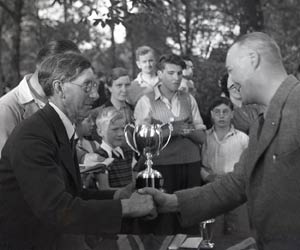 |
| Ted with tug 'Ida' | Ted, Daisy and Bill Everitt. ETW in background | Ted presenting the trophy |
Seeing the output of engines and boats, it is difficult to believe that Ted had no engineering training, and initially, little in the way of equipment. In an interview he said that he gradually obtained equipment, often by doing work for others. Indeed the 4" round bed Drummond that he used for most of his life was earned largely by doing jobs for ‘Uncle Jim’ Crebbin. Impressive though the power plants are, it was Ted’s skill working with sheet metal and tinplate that set him apart from most other competitors. His method of hull construction seems relatively simple, but is far from it, given some of the complex hull shapes he produced. According to the late Norman Phelps, Ted would start with a ‘buck’ made from orange boxes and plasterers laths. This he would ‘plate’ with sections of tin cut from whatever containers were to hand. He reported that Cocoa tins were a favourite. In order to create a joint that could be soldered, each plate overlapped the previous one, starting from the stern and working forward. Each plate was shaped and formed until it lay flat on the buck, so that there was no stress built into the hull or joints. The shaping was achieved by ‘stroking’ the tin over a flat iron. The plates were soldered together with a large iron heated either in the living room fire or in the gas ring.
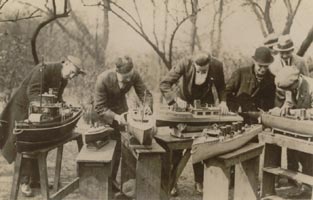 |
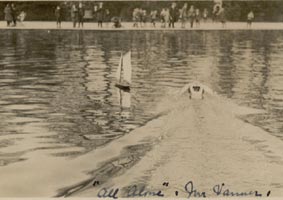 |
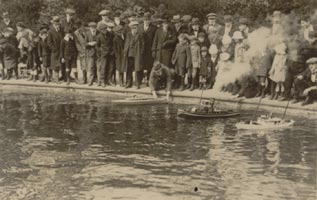 |
| Ted with 'All Alone' and 'Ledaette' | 'All Alone'. Power gives way to sail? | Ted launching 'All Alone' |
Once completed and removed from the buck, the bare hull was relatively floppy until interior frames, bulkheads and deck beams were added as required. The decks, cockpits and coamings would then be added to create a rigid, if weighty structure. The raw edges of tin would be finished with beading or by sawing a slit in one side of a piece of brass tube and soldering that over the edge. A prop shaft and one or two large rudders under the stern would complete the job, which would then have the power plant, controls, accessories and decorative touches added. Even though most of his boats were intended for racing and competition each had a deck hand painted and lined to give the appearance of planking, with ventilators and deck fittings such as portholes, flag staffs, snubbers, cleats, bollards, and seemingly whatever took his fancy or was to hand to preserve the semi-scale nature of the boats.
|
All of Ted's early boats were steam driven, with either a basic single cylinder units or the much more complex multi cylinder plant as seen in the Leda boats. The engines were, in a way, ‘modular’ with three separate single acting cylinders, each with their own valve in the cylinder head. What made them even more complicated was that the crankshaft was arranged with the pins at 120 degrees so that each of the valves had to be operated by its own eccentric or return crank. The design of the valve operating gear is fascinating with the valves for cylinders one and three running on the same shaft as the valve for cylinder two. ‘Ledaette’ had a single cylinder version of this arrangement, but unfortunately the original plant in ‘All Alone’ was taken out during restoration, and was believed to have been scrapped. Happily, this proved not to be the case as an email in April 2014 revealed that the motor had been passed on to Alwyn Greenhalgh along with other Vanner memorabilia as described in 'The Vanner Legacy' below. |
|
|
|
Of the IC engines he built for his later boats, we have a much better idea as at least three examples still survive, including ‘Leda III’, which although restored is in mechanically original condition. All the engines that Ted used were based on the same principle as used by Smith, Mills and Fred Westmoreland, which was a single cylinder four-stroke motor, laying horizontally and driving the prop shaft through a pair of bevel gears. Most of the motors were designed from the start to be mounted horizontally, so had a pair of flat mounts cast into one half of the crankcase. |
Although we know that Ted did use Belvedere castings, W.J. Smith, and we believe F.A. Mills as well, emigrated to Australia before the First War, so that later castings must have come from some other source. Certainly the motor used by Fred Westmoreland and one of Ted’s is quite similar and there are elements of early Stuart Turner in both as well. This style of motor died out quite quickly leaving Ted using castings for conventional motors, including the Westbury Kiwi, adapted for horizontal mounting with new crankcase castings. One of his later engines does have conventional mounting lugs, but to accommodate this the hull has been fitted with vertical mounts so that the motor could still lay flat.
|
Bearing in mind that Ted was using an IC engine when they were at the very beginning of their development, their mode of operation was significantly different to what we understand today. Firstly, there was only one cam, which operated the exhaust valve. The inlet valve was controlled by a light spring and opened on the down stroke of the motor, sucking in the new charge. This was ‘atmospheric induction’. Initially there were no carburetters as we know them either. The air would pass over a pool of petrol in a container combining with the vapour, before entering the cylinder. Later he would try a wick system and then a Petrolite device, before adopting a Westbury influenced design. Right: Ted with fellow hydro men at Brockwell Park |
|
|
|
Remarkably, given the development of four-stroke engine design from the 1920s onward, Ted continued to use atmospheric induction with the single cam and pushrod almost to the end of his career. Ignition for his early engines would have been by a trembler coil from a car, or as sold later by Gamages and Economic Electric. All this needed a fairly hefty accumulator as well, leading to relatively heavy boats. The only method available to control the speed of these boats was to vary the amount of air and vapour entering the motor and by advancing and retarding the ignition. Left: Daisy and Ted on right of photo at Blackheath |
In spite of all this, Ted’s boats were very easy to start with the ‘key method’ he used, very reliable by all accounts, and certainly not slow. Indeed they needed to be throttled back considerably when straight running as 18lbs of boat at 20+ mph would concentrate the mind of the catcher somewhat. One of Ted’s later boats still exists to give us an idea of the layout, the accessories and controls for the engine and the hull design and method of construction.
Probably the last boat Ted built was around 1952, and this was again one of his ‘high speed cruiser’ designs. The one unusual feature that would be so useful 60 years later was the horizontal four-stroke motor, which Ted had on the MPBA stand at the ME Exhibition that year. What set this motor apart from his others was that ‘the motor follows the Leda III traditions but has both valves mechanically operated for a change’. This was achieved by the simple expedient of grafting an extension onto the cam box for an extra cam, follower and pushrod. We do know the sad fate that befell this boat, but there was a happy and unexpected ending to the sorry tale as is related below.
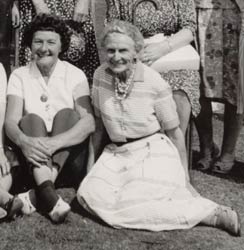 |
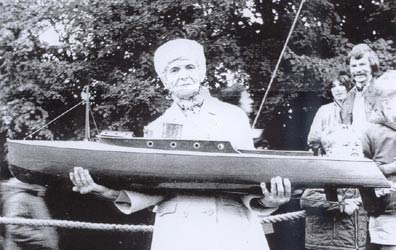 |
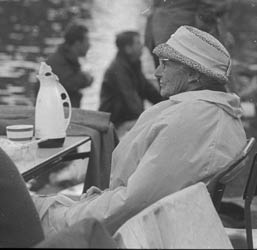 |
| Daisy with Olive Cockman | Daisy and 'All Alone'. A young Keith Reynolds in background | Daisy at St. Albans |
The Vanner ‘legacy’
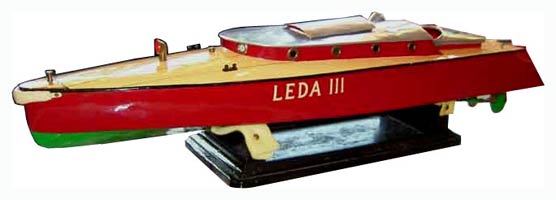
Ted Vanner died in May 1955, although Daisy would attend regattas for the rest of her life, being asked to present prizes on a regular basis. In 1969 she wrote to Alwyn Greenhalgh asking if he would restore ‘Leda III’. This he agreed to, eventually being given the boat on the proviso that it was restored and made to run again.
|
The full story of the restoration can be read in Model Boats for Dec 1980, but the restoration was completed in time for the boat to make its first public appearance at the Grand in 1973, where Daisy witnessed it running again after 18 years. She was also present at the International at St Albans that year when it was run again, but that would be the last time she saw the boat as she died on the 18th Sept 1973. ‘Leda III’ remained in the Greenhalgh collection until his death when it was passed, along with much of his other material to be cared for by Tim Westcott. Right: Alwyn Greenhalgh with Alan Rayman and the restored Leda |
|
|
|
‘All Alone’, built in 1920, stayed with the Victoria Club after Ted's death, being run on occasions by club members. At the same time as 'Leda III' was passed to Alwyn Greenhalgh, Daisy asked Alan Rayman to take over 'All Alone' and restore it. Alan replaced Ted’s original three cylinder steam engine with a single cylinder Stuart Turner 10V changing the boiler at the same time. From 1970 until 2001 'All Alone' was operated by the Blackheath Club until Alan in turn passed it back to the Victoria Club and the care of Don Reynolds, where it now resides. Pictured here at Alexandra Palace on the Victoria Club stand. |
As well as Leda III, recent emails have revealed that Alwyn Greenhalgh was also given the power unit from 'All Alone' as well as an extensive collection of photos and notes that Ted had gathered during his long career.
|
|
|
|
|
All Alone's three cylinder power unit with 'shaving stick' exhaust collector |
||
‘Ledaette’ has travelled a bit further, making its first move to Jim Burgess of the Cheltenham Club and then to the Swindon Club and Wally Hood, eventually becoming the prized possession of George Kirkham. However, an enthusiast up in Bolton hankered after it to such an extent that he eventually made George an offer ‘he could not refuse’ and became the new owner, retaining it to the present day.

Information is scarce about the only other Vanner boat to survive in original condition and this one turned up in an auction up in Nantwich, Cheshire in 1988. It has all the hallmarks of one of Ted’s boats, including the horizontal motor, still with atmospheric induction, the hull shape and the hand painted and lined ‘planked deck’. The boat carries a St Albans registration SA 62, which may give us a clue as to its more recent history. There is a wonderful contrast in workmanship between the very precise throttle and ignition control and the induction system made from commercial pipe fittings.

In January 2014, another surviving 'Vanner' boat came to our attention. This is 'Martina', built by Ted in 1938 for another member of the Victoria Club, Arthur Perkins. The present steam plant was built by Arthur and Alan Rayman and fitted around 1961, no details are known of the original power source. The boiler was rebuilt in the 1970s and the hull re-decked by Don Reynolds, the current owner. A comparison with the hull above shows a close family likeness including the stepped deck, the rear compartment and even the four portholes, which may give some indication of the age of the green boat.

Now to the sad tale of what is possibly one of the very earliest boats of Ted's to be discovered. At some stage, it went through the hands of a dealer, before being bought by a collector, who later stripped out all the motors from the boats he had and then took the hulls down to the tip! Eventually he put the motor on ebay, where it was recognised as one of Ted’s, yet sold for considerably less than if it had been a commercial motor. It was however just an engine on a shelf until a quirk of fate intervened. On a visit to see ‘Ledaette’ and the other Vanner boat, a pile of discarded hulls was discovered in the corner of the extensive loft. Unbelievably, at the bottom of the heap was one of Ted’s very early original single step hydroplane hulls, probably dating from around the First War. It was not all good news though, as the original motor and all the internal fittings had been removed to convert it into a radio controlled boat with a modern Channel Island Special, four stroke motor.
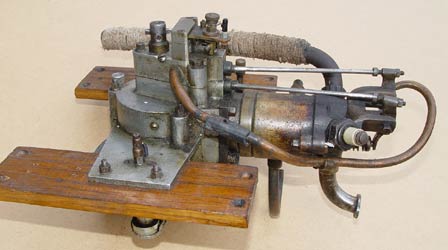 |
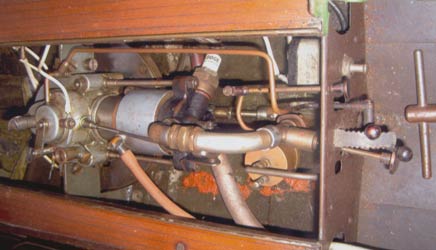 |
| Original motor with later cambox extension | Horizontally mounted 'vertical' motor with controls |
Underneath the grime though, it was in remarkably good condition after nearly 100 years, with the lining and painting on the deck still being pristine. This presented an interesting possibility. Would the original Vanner motor, fit into an original Vanner hull? Happily, the answer was yes as even the prop shafts were the same size and the right hand rotation prop was correct for the engine. It is not inconceivable that this is where the motor originated from, given the ease that it went back in. A number of holes had been cut in the hull to accommodate the modern motor, all with little thought, but with the judicious use of patches and utilising holes in the deck for accessories, a major rebuild was avoided. What could not be avoided, owing to fire in the bowels of the hull at some time, was a partial repaint, but by only painting up to the waterline all Ted’s original deck lining could be retained. This makes seven Vanner boats that we can account for plus rumours of one more. If there are others out there, then we would be delighted to hear about them.

The discovery of one of Ted’s boat, now approaching 100 years old, and an engine of the same vintage, along with the coincidental donation of original photographs has encouraged us to put together this article.
None of it would have been possible however without the generous
assistance of Alan Whitehead, George Kirkham, Ken Lawton,
Phil Abbot, Peter
Hill, Eric Offen, Keith Reynolds and the late Norman Phelps and
Terry Everitt. Additional original images by courtesy of the Westbury
family.
We are
particularly grateful to Tim Westcott for material from the Greenhalgh
collection, and for allowing access to the collection via the website he has
established. Images and notes relating to Ted and Daisy Vanner and other early
material are now online at
www.antiquemodelaircraft.co.uk under the heading 'boats'.
Don Reynolds informed us that Spitalfields Life has published a lovely set of
photos of Ted and Daisy Vanner
Spitalfields Life
©copyrightOTW2014